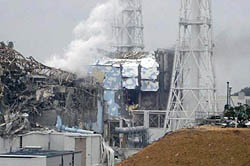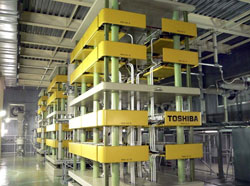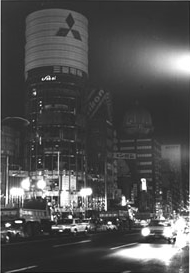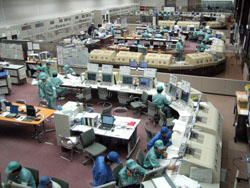
Fukushima I nuclear power station accident

Fukushima I units 3 and 4 shortly after the outbreak of the accident (photo courtesy of TEPCO)
An enormous tsunami triggered by the Great East Japan Earthquake in March 2011 disabled the cooling capability of Tokyo Electric Power Company’s (TEPCO) Fukushima I nuclear power station. This resulted in a severe accident where three of the station units suffered core meltdown. Of the six units of the station, units 1, 3 and 4 had their reactor buildings severely damaged by hydrogen explosions. The released radioactivity totaled 770,000 terabecquerels (iodine-equivalent), and residents in a wide area of Fukushima Prefecture evacuated.
Because the Fukushima II nuclear power station, located at about 10 kilometers south of Fukushima I, was shut down and several thermal power plants were also damaged, TEPCO lost 40 percent of its supply capacity and the Tokyo metropolitan area got into a tight power demand-supply situation. This led TEPCO to conduct rolling blackouts on ten weekdays from March 14 to 28. The utility made efforts to recover supply capacity by restoring thermal power plants that suffered damage and restarting thermal power plants that had been closed for long time periods. Although power shortage continued until the summer of 2011, rolling blackouts in the summer could be avoided owing partly to the social inclination toward power saving.
On the other hand, the cost of damage compensation weighed heavily on TEPCO’s business. To facilitate compensation, the Japanese government enacted the Act to Establish the Nuclear Damage Compensation Facilitation Corporation on August 3, 2011 and brought it to effect on August 10. Through the Nuclear Damage Liability Facilitation Fund, established according to the Act, the government put public money into TEPCO. The company was put under the government control, and its financial ground was improved substantially. The company raised electricity rates in September 2013 and prepared for committing to damage compensation, decommissioning and stable supply of electricity.
Difference in power frequency between western and eastern Japan

Two electric power frequencies are used in Japan (photo: Shinshinano frequency converter station that allows power exchange between eastern and western Japan)
An urban center in Western Japan, Osaka, tends to have a sense of rivalry against the Japanese capital, Tokyo. This sense of rivalry resulted in a feature of the Japanese electric industry.
The frequency of alternating current in Japan is set to either 50 Hz or 60 Hz. Broadly speaking, 50 Hz is adopted in eastern Japan and 60 Hz in western Japan. It is rare in the world that electricity is supplied by using different frequencies in a single nation. The presence of the two difference frequencies can be traced back to the competition between Tokyo and Osaka during the burgeoning of the electric industry in Japan.
The Japanese electricity business started with the foundation of Tokyo Electric Lamp Company in 1883. Later, electric light companies were founded one after another in major cities throughout Japan. The pioneering Tokyo Electric Lamp installed power generators imported from overseas for other electric lamp companies, whereas Osaka Electric Light Company, which was founded in 1888, took its own independent path. In around 1896 and 1897, Tokyo Electric Lamp imported 50 Hz alternating-current generators from Allgemeine Elektrizitats Gesellschaft AG (AEG) of Germany, and Osaka Electric Light imported 60 Hz alternating-current generators from General Electric (GE) of the United States. This difference had a lasting impact, so that the 50 and 60 Hz frequencies are now being used in eastern and western Japan, respectively.
Today, three electric companies in eastern Japan–Hokkaido Electric Power, Tohoku Electric Power, and Tokyo Electric Power–adopt 50 Hz, whereas seven electric companies in western Japan–Chubu Electric Power, Hokuriku Electric Power, Kansai Electric Power, Chugoku Electric Power, Shikoku Electric Power, Kyushu Electric Power, and Okinawa Electric Power–adopt 60 Hz. For power exchange between eastern and western Japan, frequency conversion stations have been set up by three utilities: J-Power, Tokyo Electric Power, and Chubu Electric Power.
Energy self-sufficiency rate in Japan

Neon lights were extinguished in Ginza, Tokyo under the influence of skyrocketed crude prices in the 1970s
The economy of Japan, which had been seriously damaged by its defeat in World War II, recovered to the prewar level by around 1955 and then further grew dramatically until 1973. This economic growth was supported by the import of oil from the Middle East, with 76% of energy supply in Japan depended on oil in fiscal 1973.
The Japanese economy was seriously disrupted by the skyrocketed crude-oil prices triggered in 1973 by the Fourth Middle East War. The high oil prices had a great impact on people’s life, causing the suspension of late-night TV broadcasting and the extinction of neon signs as well as buying up of toilet paper and detergents, which were not directly related to oil prices. After the oil shock, oil prices rose sharply again in the wake of the Iranian Revolution in 1978. Although the economic turmoil experienced in 1978 was not as serious as the one in 1973, Japan promoted the introduction of energy sources other than oil, including nuclear power, natural gas, and coal, as well as the development of new energies including photovoltaic generation , in light of the past two occasions of elevated oil prices. As a result, the share of oil in the total energy supply in fiscal 2006 was reduced to 44.1%.
Nonetheless Japan relies on import from overseas for almost all the natural gas and uranium, a fuel for nuclear power generation, which are alternative energy sources the country has been introducing in place of oil. The rate of energy self-sufficiency in 2005 is only about 4%, which includes hydroelectric power generation. Given the scarce underground resources in Japan, it is almost impossible for the country to significantly increase the rate of energy self-sufficiency in the future. Japan is therefore promoting the development of nuclear power generation as a “quasi-indigenous” source of energy, whose fuel is relatively easy to stockpile and can be recycled through reprocessing. (Reference: Fiscal 2007 Energy White Paper)
Rokkasho, village of energy

Central control room at the spent fuel reprocessing plant
Aomori Prefecture has a key role in the Japanese energy policy. Other than hosting nuclear-related facilities, the prefecture is aggressively promoting renewable energy sources such as wind, solar, and hydrogen power.
Rokkasho-mura, situated at the base of the Shimokita Peninsula on the Pacific coast side, is the center of such activities. Rokkasho-mura hosts a national oil storage base, nuclear fuel cycle facilities, and wind power generation facilities. Construction of facilities related to the international fusion energy research project is now in preparation.
The Rokkasho spent fuel reprocessing plant, one of the nuclear fuel cycle facilities of Japan Nuclear Fuels Ltd. (JNFL), is in the last and most important phase before commercial operation. An active test, performed under the condition close to that of full-scale operation, was started in the end of March 2006, and the test entered the fifth step (last stage) in February 2008.
Approximately 430 tons of spent fuel from nuclear power stations is being used in the active test to confirm the operational performance and safety functions of the plant. In the first to third steps, the performance and safety of equipment in the buildings related to such processes as shearing, dissolution, separation, purification, and denitration are confirmed. In the fourth to fifth steps, the performance and safety of the entire plant is confirmed. JNFL President Isami Kojima said “we are determined to complete the plant with a sense of mission in close relationship with partner companies, while giving top priority to safety.”
Given that Japan is poor in natural energy resources, retrieval and reuse of uranium and plutonium are essential for using valuable uranium resources efficiently. Besides, the recycling reduces the amount of radioactive waste to less than half, compared with direct disposal of spent fuel. Operation of the Rokkasho spent fuel reprocessing plant is much anticipated by the Japanese electric industry as a key in the nuclear fuel cycle.
To ensure peaceful use of nuclear materials and to confirm that plutonium in the plant is not diverted to nuclear arms, inspectors of the Japanese government and the International Atomic Energy Agency (IAEA) are permanently stationed at the plant on a 24-hour basis. The nuclear material inventory in the plant and other data are declared to the IAEA through the government, and both the government and the IAEA confirm the actual inventory through inspection. These activities prevent illegal removal of plutonium from the plant.













